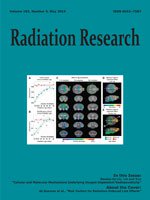Exposure to high-dose radiation results in deleterious effects on skeletal tissue. However, the effects of combined trauma such as radiation and hemorrhage on skeletal properties have yet to be elucidated. The purpose of this study was to evaluate the effects of radiation injury combined with hemorrhage on trabecular bone properties and biomarkers of bone metabolism, and to determine whether hemorrhage enhances radiation-associated bone loss. Male CD2F1 mice (10 weeks old) were exposed to one single dose of gamma radiation (60Co): 0 or 7.25 Gy. Two hours after irradiation, animals were bled 0% (n = 8) or 20% (n = 8) of total blood volume via the submandibular vein. Mice were euthanized 30 days after irradiation, and distal femora were analyzed using standard histomorphometry to determine changes in trabecular bone volume (BV/TV), thickness (Tb.Th), spacing (Tb.Sp), number (Tb.N) and marrow adipocyte density. Femurs from mice euthanized 1, 7 and 15 days post injury were flushed and total bone marrow cells were counted. Radiation exposure resulted in deleterious effects on distal femur BV/TV (−63%), Tb.Th (−34%), Tb.N (−45%), Tb.Sp ( 125%) and adipocyte density ( 286%) compared with the sham-irradiated mice (0 Gy; P < 0.05). Hemorrhage after irradiation resulted in greater deleterious effects on the distal femur with BV/TV (−13%), Tb.Th (−44%), Tb.N (−26%), Tb.Sp ( 29%) and marrow adipocyte density ( 33%) compared with radiation exposure only (P < 0.05). Analysis of the biomarkers of bone metabolism in serum from irradiated and hemorrhaged mice revealed significantly lower levels of osteocalcin (−60%) and procollagen type 1 amino-terminal propeptide (−36%; P1NP, biomarkers of bone formation activity), as well as elevations in sclerostin ( 56%; SOST, an inhibitor of bone formation) compared with serum from irradiated only mice (P < 0.05). Additionally, the onset of bone marrow cell depletion in irradiated and hemorrhaged mice occurred earlier and to a greater extent compared to that in irradiated only mice. This study provides definitive, preliminary evidence that hemorrhage further exacerbates trabecular bone loss associated with nonlethal high-dose gamma radiation.
How to translate text using browser tools
21 April 2015
Hemorrhage Trauma Increases Radiation-Induced Trabecular Bone Loss and Marrow Cell Depletion in Mice
Joshua M. Swift,
Joan T. Smith,
Juliann G. Kiang





